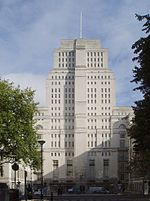- University Marine Biological Station Millport
-
University Marine Biological Station Millport 
Established 1897 (as Millport Marine Station) Type Public HE Institution Acting Director Prof. P. Geoff Moore Admin. staff 4 Location Millport, Great Cumbrae, Scotland Campus Marine biological lab. Affiliations University of Glasgow, University of London Website www.gla.ac.uk/centres/marinestation The University Marine Biological Station Millport (UMBSM) is a higher education institute located on the island of Great Cumbrae in the Firth of Clyde, Scotland. It is run jointly by the universities of Glasgow and London (of which it is a listed body).
Located just outside the town it has an interesting curriculum and research programme, with an influx of students throughout the academic year. A Museum and Aquarium (named after founder, David Robertson) is open to visitors.[1] In May 2003 the station took delivery of the Macduff-built, 22 metre marine research vessel, RV Aora. UMBSM also functions as a Meteorological Office Weather Station and Admiralty Tide Monitor.
History
The Ark, an 84ft lighter was fitted out as a floating laboratory by the father of modern oceanography, Sir John Murray. She formed the Scottish Marine Station for 12 years from 1884. In 1885 she was moved from Granton and drawn up on the shore at Port Loy, Cumbrae.[2] She attracted a stream of distinguished scientists drawn by the richness of the fauna and flora of the Firth of Clyde. The Granton station eventually closed in 1903.
In Millport, amateur naturalist David Robertson was encouraged by meeting Anton Dohrn and by the wealth of findings from the Challenger expedition. In 1894 he formed a committee to build a marine station in Millport and took over The Ark. Millport Marine Biological Station was opened in 1897 by Sir John Murray. The Ark was totally destroyed by a great storm on the night of 20 January 1900.[3]
On 21 July 1904 Scotia, the ship of Dr William Speirs Bruce's Scottish National Antarctic Expedition, returned to her first Scottish landing site, on the Isle of Cumbrae.
From this beginning the station was gradually built up to its present size. The original building proved too small for the purpose and an architectural copy was built alongside.
Notes
- ^ "Marine Station". Millport - Simply Magic!. http://www.millport.org/marine-station. Retrieved 5 October 2010.
- ^ "Original Ark". University of Glasgow. http://www.gla.ac.uk/centres/marinestation/UMBSM_the_ark.html. Retrieved 2007-03-04.
- ^ PG Moore & JA Gibson (January 2007). "Marine Station at Millport". The Linnean 23 (1): 31–49.
External links
- "University Marine Biological Station Millport – official website". http://www.gla.ac.uk/centres/marinestation/. Retrieved 2007-03-04.
- "SAMS History". http://www.sams.ac.uk/about-us/our-history. Retrieved 2008-10-19.

History Bishop Turnbull · Queen Margaret College · Academic dress · Parliamentary Constituency · Lion and Unicorn Staircase · Memorial Gates · List of University of Glasgow people · List of Professorships · Snell ExhibitionDepartments Dental School · Glasgow Cardiovascular Research Centre · Humanities Advanced Technology and Information Institute · School of Law · Medical School · Robertson Centre for Biostatistics · Trinity College · Vet SchoolFacilities Hunterian Museum · Glasgow University Library · Memorial Chapel · Archives of the University of Glasgow · Marine Biological Station · Boyd Orr BuildingStudents BodiesStudents' Representative Council · Glasgow University Sports Association · Glasgow University Union · Queen Margaret UnionClubs &
SocietiesBoat Club · Conservative Association · Dialectic Society · Labour Club · Medico-Chirurgical Society · Rugby Football Club · Scottish Nationalist Association · Glasgow University Royal Naval Unit · Glasgow and Strathclyde Universities Officer Training Corps · Universities of Glasgow and Strathclyde Air SquadronMedia Universities in the United Kingdom
Universities in the United KingdomEngland LondonBirkbeck · CSSD · Courtauld · Goldsmiths · Heythrop · ICR · IoE · King's · LBS · LSE · LSHTM · Queen Mary · Royal Academy of Music · Royal Holloway · RVC · St George's · SOAS · School of Pharmacy · UCLOtherBrunel · City · East London · Greenwich · Kingston · Imperial · London Met · London South Bank · Middlesex · RCA · Roehampton · UAL · Westminster · West LondonMidlandsAston · Birmingham · Birmingham City · Coventry · De Montfort · Derby · Keele · Leicester · Lincoln · Loughborough · Northampton · Nottingham · Nottingham Trent · Staffordshire · Warwick · Wolverhampton · WorcesterNorthBolton · Bradford · Central Lancashire · Chester · Cumbria · Durham · Edge Hill · Huddersfield · Hull · Lancaster · Leeds · Leeds Metropolitan · Liverpool · Liverpool Hope · Liverpool John Moores · Manchester · Manchester Metropolitan · Newcastle · Northumbria · Salford · Sheffield · Sheffield Hallam · Sunderland · Teesside · York · York St. JohnSouthAnglia Ruskin · Bath · Bath Spa · Bedfordshire · Bournemouth · Brighton · Bristol · Buckingham · Buckinghamshire New · Cambridge · Canterbury Christ Church · Chichester · Cranfield · Creative Arts · East Anglia · Essex · Exeter · Gloucestershire · Hertfordshire · Kent · Oxford · Oxford Brookes · Plymouth · Portsmouth · Reading · Southampton · Southampton Solent · Surrey · Sussex · UWE · WinchesterNorthern Ireland Scotland Aberdeen · Abertay Dundee · Dundee · Edinburgh · Edinburgh Napier · Glasgow · Glasgow Caledonian · Heriot-Watt · Highlands and Islands · Queen Margaret · Robert Gordon · RCS · St Andrews · Stirling · Strathclyde · UWSWales Aberystwyth · Bangor · Cardiff · Cardiff Metropolitan · Glamorgan · Glyndŵr · Newport · Swansea · Swansea Metropolitan · Trinity Saint DavidNon−geographic University colleges Birmingham · Bishop Grosseteste Lincoln · Bournemouth · BPP · Falmouth · Harper Adams · Leeds Trinity · NCH · Newman · Norwich · Plymouth St Mark & St John · St. Mary's (Belfast) · St. Mary's (Twickenham) · Stranmillis · SuffolkUniversity centres Related 
This United Kingdom university, college or other education institution article is a stub. You can help Wikipedia by expanding it.

